|
A short summary |
In 2017 we have moved majority of plants from Vienna, Austria to
Ven, island of Sweden with a normal range of temperatures from
-15C winter/+35C summer in Vienna to -5/+25 on Ven.
Knowing how the plants were "behaving" in Vienna we can
observe and compare the growing conditions. The peaches and
apricots do not give fruits (the minus/plus fluctuations
continue until May) despite milder climate on Ven. The prunus
plants are often sick. On the other side Oleander survives
in the protected area, also Fig and Eriobotrya. Taking into
account formal categories of the hardiness scales the conditions
are better on Ven hence we try to figure out what factors are
included in the hardiness definition. |
|
the climate and soil condition on the island
of Ven. |
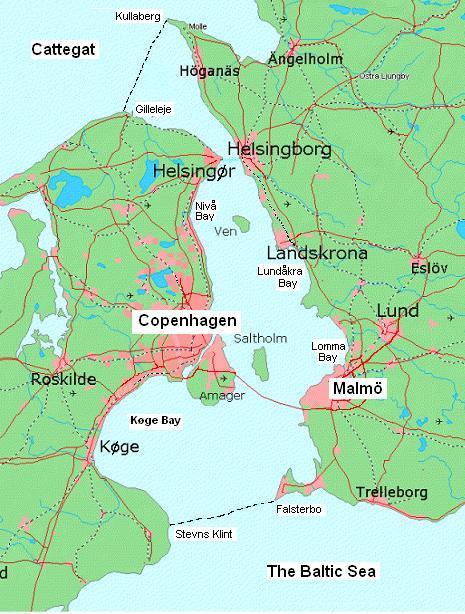 The
island of Ven is situated between Sweden and Denmark, 20
km north from Copenhagen and north-west of the town of
Landskrona. The island is a flat plateau (imagine a cake) about
30-40 m above the sea level. There are very few trees and the
only areas protected from wind are shore areas and the
protection is only possible if the wind is coming from the
opposite directions. The winds are mostly from the South-West
directions but in the winter time, a cold dry wind may come from
the East. The
island of Ven is situated between Sweden and Denmark, 20
km north from Copenhagen and north-west of the town of
Landskrona. The island is a flat plateau (imagine a cake) about
30-40 m above the sea level. There are very few trees and the
only areas protected from wind are shore areas and the
protection is only possible if the wind is coming from the
opposite directions. The winds are mostly from the South-West
directions but in the winter time, a cold dry wind may come from
the East. |
|
The climate general information |
Ven has maritime, relatively mild winters (mostly around 0 C)
but during our 3 years on the island one night the temperature
fell t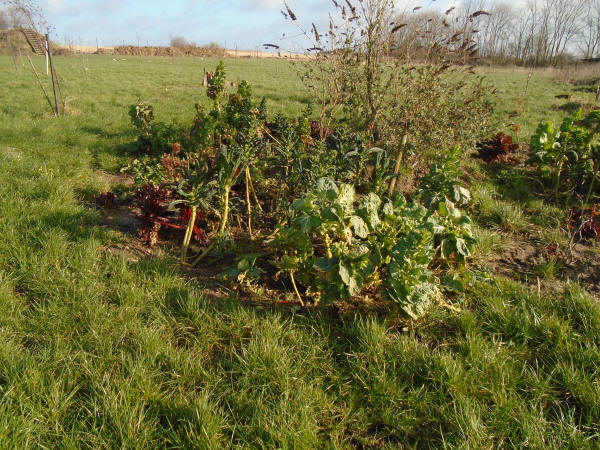 o
-11C. The summer time temperature is around 18-22
without any hot tops. The photo on the side shows
vegetables and budleja with some leaves in Febuary. o
-11C. The summer time temperature is around 18-22
without any hot tops. The photo on the side shows
vegetables and budleja with some leaves in Febuary.
Comparing to Vienna/Austria where the
winter time the temperature was -5 to -10 with down to -20 night
time at night but we have experience +40 C one summer. It is
important to know our reference location as we in 2017, took
many plants from Vienna and planted them on Ven. The fall is
prolonged due to influence of the see around but spring is slow
to enter Ven, due to the same reason.
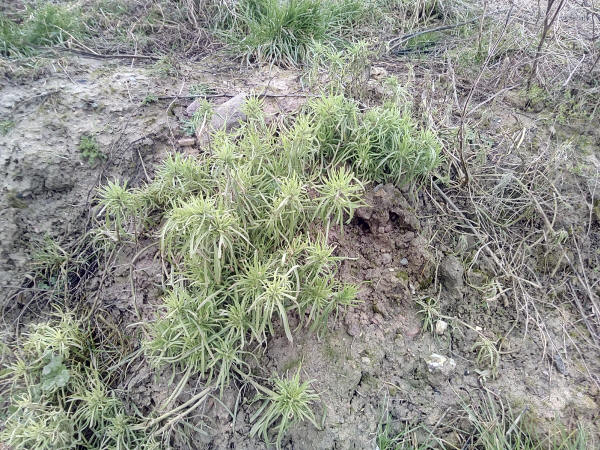
Sesame plants survived winter, very very strange. They were
planted randomly, we bought dozen of various spices and spread
in the garden, just to see what will come up.
|
|
Local climate on Ven, some specific observations. |
We have lived also on the cost in Italy, north of Rome and of
course in Vienna. We have then noticed some
particularities/anomalies in the climate on Ven. During winter
there are frequent oscillation of temperature around 0C. it will
go up to +5 during day and fall to -3 at night. It happens that
that temperature in February may go up during the day to +10 C
and stay on the plus side during the night. On the picture we can see a cydonia plant which
developed leaves too early, this is 12 March, the cold
nights are "burning" the tops, the plants is protecting itself
from strong sun buy coloring the leaves brown. In 2020 the
peaches started to go in bloom already at the end of February,
apricots in March. (of course all fruits were lost and the leave
buds “restarted” again. ) Then there is a risk that the frost
may come as late as in
the night. On the picture we can see a cydonia plant which
developed leaves too early, this is 12 March, the cold
nights are "burning" the tops, the plants is protecting itself
from strong sun buy coloring the leaves brown. In 2020 the
peaches started to go in bloom already at the end of February,
apricots in March. (of course all fruits were lost and the leave
buds “restarted” again. ) Then there is a risk that the frost
may come as late as in
May and the sun radiation in May is very
strong and long. Ven is an island and there are long periods of
very sunny weather, one has an impression that the clouds avoid
the island. |
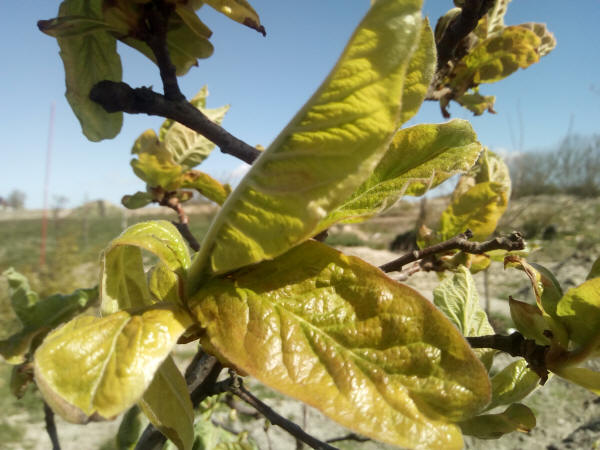 The
clorosis is extreme during the spring, The
clorosis is extreme during the spring,
All leaves are either yellow or
brownish. |
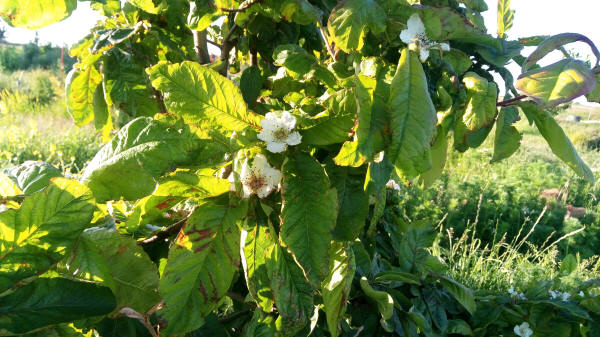 Flowers
of mipilus at the beginning of June. The leaves are burned by
earlier frosts, but the late flowering ended with a lot of
fruits. Flowers
of mipilus at the beginning of June. The leaves are burned by
earlier frosts, but the late flowering ended with a lot of
fruits. |
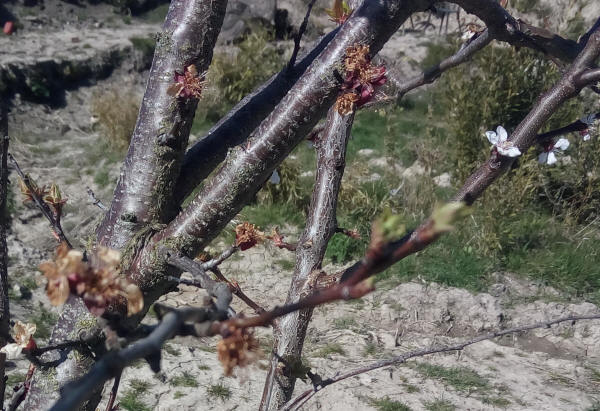 Apricots
tree, April, very strong sun, the flowers develop near the thick
braches which get heated but get cooled during night, get
dry and die. I think i have seen similar conditions in Korea
with cold winds from Siberia in Spring. Apricots
tree, April, very strong sun, the flowers develop near the thick
braches which get heated but get cooled during night, get
dry and die. I think i have seen similar conditions in Korea
with cold winds from Siberia in Spring. |
|
The soil |
|
According to an official classification the soil is absolutely
at the top quality in Sweden. The humus layer is about
30-50 cm resting on a clay base. The soil is very alkaline. |
|
Precipitation and water conditions. |
We have been only 3 years on island and do not have any long
interval for making conclusions. Apparently the last 3 summers
2018, 2019, 2020 were exceptional. We have observed extremely
dry weather, with a very uneven reinfall distribution. The
late winter mid-January and February were very rainy then 3
month the precipitation is minimal. The annual participation is
around 500 mm if one interpolates from the towns located in the
vicinity, in Sweden and Denmark.
The water retantion on the island is a difficult question.
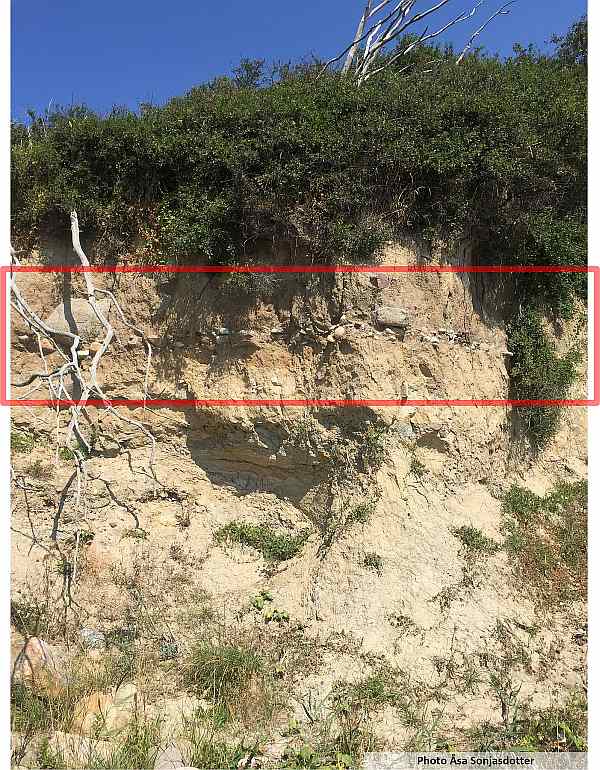 It
seems that the clay is interwoven with a net of mash structure
of clay sand and gravel (at approcimatelly 2-5 m depth) so the
surface water disappears relatively quickly and is not forming
permanent ponds. The astronomer Tycho Brahe in 16 th century
created a chain of connected ponds in order to collect water for
his paper mill. We assume this way he was preventing loss all
water if he would dig one big artificial lake. By testing water
retention in small ponds he was able to choose location without
drainage to the underlying porous structures and outflow to the
sea, see the picture It
seems that the clay is interwoven with a net of mash structure
of clay sand and gravel (at approcimatelly 2-5 m depth) so the
surface water disappears relatively quickly and is not forming
permanent ponds. The astronomer Tycho Brahe in 16 th century
created a chain of connected ponds in order to collect water for
his paper mill. We assume this way he was preventing loss all
water if he would dig one big artificial lake. By testing water
retention in small ponds he was able to choose location without
drainage to the underlying porous structures and outflow to the
sea, see the picture
We have created several ponds but unfortuanatelly they loose
water after 2-3 month.
|
|
|
